This is an unedited version of the article which was published in Child Care Information Exchange magazine in May 2001. To see an actual copy of the published article in Adode Acrobat format (PDF) click here. To learn more about Child Care Information Exchange magazine, click on the magazine name.
Role of Culture in Designing Child Care Facilities
by Vicki L. Stoecklin
©1999 White Hutchinson Leisure & Learning Group
"Culture is the framework that guides and bounds life practices" [3]. It is said by cultural researchers that cultural understanding is normally established before age five. As child care centers are being built around the world, it is important that even at the schematic design phase, we create children's environments which reflect the culture, values and traditions of the country or area where they are being located. Research has clearly proven the need for appropriate physical environment for children. The purpose of this article is three fold:
- - to explain to practitioners the research process needed to create a culturally reflective building and environment.
- to assist practitioners in understanding the role of culture in the architectural and interior design process.
- to use an example of our work in the Middle East to create a better understanding of families and children whose origins are from the Persian Gulf region, particularly the country of Qatar, and who follow more traditional Arab lifestyles.
I have been interested in the Persian Gulf since my first position in the early 1980's as an Early Childhood Director included working with many international families including ones from the Middle East. At that time, very little was written on the concept of cultural competence in early childhood education so both families and our staff struggled immensely when western ideas contradicted traditional Muslim values.
My position now is far different than that of an Early Childhood Administrator, however, I am eager to apply my early childhood background in another very important field, the field of children's environmental design and consulting. I am part of a firm, the White Hutchinson Leisure and Learning Group, that specializes in the design of children's facilities in both the education and leisure industries. Another interesting career track I might add for an experienced early childhood professional.
Our firm has been asked to design a children's play facility similar to a children's museum in the country of Qatar. In addition, through our research, this project was found to be in need of a model employer supported childcare program. Doha, the capital of Qatar, only had one child care center in 1998 when we started our research. Clearly if we wanted to get women to work at the children's play facility, we would to provide high quality child care as an employment benefit. This article will reflect upon our experiences in researching and studying the culture of Doha, Qatar to create a schematic design for the model employer supported child care facility.
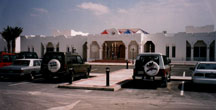
This school is a good example of culturally reflective design in Qatar.
CULTURAL CONTEXT
Culture can be an elusive topic since we become so accustomed to it that it's like a second skin. However, remove yourself from your familiar surroundings and you will begin to understand the profound effect that culture has on our behavior. Culture is not something taught yet almost every experience has a cultural component that is absorbed.
Table 1 includes cultural elements that provide a framework for daily practices. Notice that the last twelve can have a direct influence on design: gestures, language, role of nature, history/heritage, child rearing practices, family structure, territorial space, colors, textures, shapes, spatial and architectural styles.
|
TABLE 1 |
|
|
|
CULTURE AND ARCHITECTURAL CHILD CARE DESIGN
Think of all of the different styles of building and houses present in the United States and you will begin to understand the role culture has played in architectural design. Picture the pueblo inspired earth colored homes of the desert southwest, the fancy iron grill work of the buildings surrounding the French Quarter in New Orleans, the large front porches on homes in the Midwest, and the Spanish style homes with portal entries and courtyards in California to name a few.
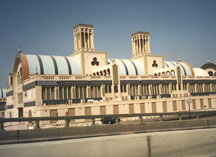
An example of traditional Islamic architecture.
Children's environmental research demonstrates that children need a homelike and comfortable physical environment yet very few childcare centers are designed to imitate homelike features. Rather, the trend in child care facility design has been to create large, unattractive institutional buildings that have little in common with the design of the child's home and home culture. Most child care facilities being constructed do little to reflect the architectural styles and features of the surrounding communities and most look the same whether they are located in Maine, Florida, or California. The saddest example I saw of this inappropriate architectural style was a child care facility I saw recently in Puerto Rico opened by an American child care firm. The building style was very incongruent with the island version of Spanish architecture and looked more like an American institution, maybe a hospital or even a prison. The interior was virtually absent of the beautiful bright colors and flowers of Puerto Rican interiors and looked very plain compared to local color and interior design preferences. The playground equipment was in bright island colors; however, it was placed in full sun with no adjacent plant materials, which was particularly disturbing since the site included large shade trees and additional plantings. Almost every child in Puerto Rico has the advantage of playing outside nearly everyday in lush green settings since it is a tropical island. How could the childcare center fail to recognize this important aspect of tropical island culture? But the most upsetting part of my visit was when I noticed that all the parent materials in the center were in English rather than Spanish, the most widely spoken language in Puerto Rican homes. Language is a very important cultural marker for both parents and children. If you have ever tried to read an important document in another language, you can identify with what I'm saying. Signage in buildings should reflect the language of the population which the facility serves. In many cases, signage may need to be done in both languages in order to be culturally appropriate. In this facility, which was designed in the United States, signs were in English only.
CULTURAL RESEARCH FOR CHILDCARE FACILITY DESIGN
Our research into the culture of Doha, Qatar took several distinct paths, which we usually modify and replicate, in studying distinct cultures overseas and different regions of the United States. Even different regions of the United States have different cultures. The most effective research methods we have used include:
- reading and studying about the culture
- talking, interviewing and working with early childhood staff, children and - - parents of the culture
- participating in the daily life of another culture and
- learning a little about the language of the culture.
READ ABOUT AND STUDY THE CULTURE
The public library, bookstores and the internet all offer a variety of easily accessible sources of information about different cultural groups and regions of the United States and the rest of the world. We start our cultural research on the internet and usually find books and articles as needed on a variety of issues including gender roles, education, parenting and social structure. Books with pictures are also helpful in understanding spatial relationships, colors, textures, and architectural preferences. When reading the material it is helpful to keep in mind that what you read about a particular culture is a generalization and that although all persons of the same cultural history may share tendencies. Individual behavior is influenced by other factions including age, soci-economic status and in some cases gender.
INTERVIEWING STAFF, PARENTS, AND CHILDREN
Working with and interviewing staff, parents and children of other cultures is always very rewarding. However, this type of research also has its challenges. It is always difficult to locate trained interpreters who are bi-cultural so you will need to sift through your information carefully since some concepts can truly get "lost in the translation". Nonetheless, this type of research can yield an immense amount of information about cultural preferences. I have learned over the years to also use a female interrupter in studying about childcare and parenting practices since I am interviewing mostly women. In most countries and regions of the United States we use parents to help guide our cultural research.
Parents, usually mothers, are interviewed in small focus groups about their preferences for children's activities using a series of colored pictures showing children doing a wide variety of educational and playful things like dress-up, water play, sand play, etc. Sometimes I facilitate the groups myself with an interpreter and at other times I observe another facilitator doing it. Focus groups with parents occur in a group of six to eight in a relaxed setting, usually in someone's home. Sometimes they are done in an exciting child care setting.
Parental focus groups usually uncover some unique preferences for their children. For example, when shown pictures of sand play, Morrocan mothers worried about cleanliness and stated that they would only allow their children in the sand if it had been sanitized and had a sign that it was clean. Women in Qatar did not have any such concerns. Both countries are basically Muslim and come from a long history of life in the desert sand, yet had very distinct values about sand play. We have also found that here in the United States, some African-American parents have concerns over sand since it takes many hours to wash and then braid their children's hair when it becomes sandy. In addition, the hair dressing set for braiding thick hair makes sand removal very difficult. One of my most rewarding experiences interviewing parents was in inner city Chicago where I found a group of parents enthusiastic about an outdoor play garden.
Another design preference that mothers expressed in Qatar is that they did not want their children to play pretend restaurant since in their country restaurant work signified a less than desired social status. Mothers in Qatar also expressed deep concerns about dress-up play in general since this country still dons the traditional garments that have been used for centuries quite unlike other regions outside the Persian Gulf. All of these parental preferences have influence on the types of equipment placed in a facility and hence have influence on design and room layout. Mothers also expressed the value of safety, supervision and cleanliness. All of these parental preferences can influence the design both inside and outside and need to be understood at the schematic design phase.
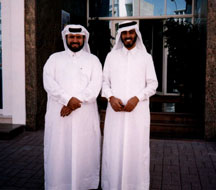
Our clients, Saaed and Hassan, wearing traditional clothing of Qatar.
Interviews with staff to identify local cultures includes visits to early childhood education centers, centers serving the disabled, public and private education facilities. Time at the site is not only set aside for interviews but to watch the facilities in operation and view classrooms. I remember fondly my visit to a girls private elementary school in Doha, Qatar where the entire school came to the courtyard to perform and welcome me like a visiting dignitary. I was presented with an arrangement of paper flowers, which still preside on the shelves above my desk. My greeting was not only done in Arabic but in English, which I am sure the children had practiced for a long time. Interviews are sometimes done with groups of early childhood teachers in a format similar to that of parents. Individual interviews were done with principals, headmasters, the ministry of Education Staff, and daycare center directors. I have often times been surprised by the similarities in teacher preferences among several countries I have visited especially in light of the tremendous variation in what we would call a developmentally appropriate environment. It's almost as if teachers intuitively know about developmentally appropriate practice but lack the training, money, and resources in how to implement it in their own environments or in teacher-child interaction. Looking at the overall education and child care system in some locations helps me to understand local philosophies and preferences.
We also do children's focus groups when we move from the schematic design phase to the final construction document process. On some projects, we do children's focus groups during the schematic phase depending on the complexity of the project. Children's focus groups are conducted in s similar fashion to those of adults; however, sometimes children are usually divided by age and gender. Dividing the children into gender groups is more crucial in those cultures where gender roles are more fixed by social norms. Children's focus groups might include games, identification of favorite colors and some drawings of what they would like in their environment.
PARTICIPATING IN THE DAILY LIFE OF ANOTHER CULTURE
Participating in the daily life of another culture is best experienced when you take the time to "get off the beaten path". We like to visit local museums, parks, leisure sites, historical centers, shops and local restaurants. Not only are these sites rich in cultural significance but they are a great place to observe parent and child interaction, social norms, expectations, and physical design preferences. My best trip "off the beaten path" was actually in a small fishing village north of Doha, Qatar. We were invited to celebrate the wedding of a sister to the client for whom we worked. Although I tried to obtain some information about wedding traditions from the Qatarian embassy, nothing could have prepared me for the uniqueness of the event I experienced. I was dropped off by the males in our party at a maksar, a very large tent with a covered opening. In Qatar, wedding celebrations are held separately for men and women since socialization between the sexes is prohibited. As I was ushered into the tent I was intoxicated by the scent of burning incense and overwhelmed by the site of close to one hundred and fifty totally veiled women sitting on sofas on over a hundred Persian rugs. I felt like time had been moved back by centuries as I watched sword dancing and listened to music played on camel skin drums. It was an experience I will never forget. The evening taught me volumes about how this culture has managed to hang onto traditional practices despite the influence of the western world. It helped to set the framework for understanding their design preferences.
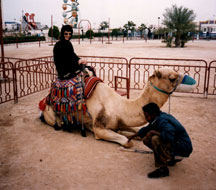
Vicki decides to experience the traditional way of travel in the Persina Gulf. Although camels are no longer used for transportation they remain an integral part of the Arab culture..
APPLYING CULTURAL PRINCIPLES IN A SCHEMATIC CHILDCARE DESIGN
Qatar is a small peninsula protruding from Arabia's eastern coast into the Persian Gulf and is known as one of the Gulf States. Other members of the Gulf States are Saudi Arabia, Bahrain, the United Arab Emirates and Kuwait. Until oil and gas were discovered in these areas in the last century, these areas were virtually undeveloped and unknown. The Arabia Gulf area is mostly desert and it's history is rich with not only desert nomads but sea faring people such as fisherman and pearl divers. Life used to be rough in a climate where summer temperatures soared to 120° F, but with the discovery of oil and gas, has come a new level of economic prosperity and comfort. Although economic prosperity has brought profound change, the people of the Persian Gulf states have a strong pride and commitment to preserve their heritage against some intrusions of Western culture.
One way in which the culture of the Gulf is preserved is through the wearing of traditional clothing and coverings. In Qatar and other Gulf States, except for Saudi Arabia, traditional clothing and veils are optional pieces of garments. Women in Qatar choose to wear their traditional coverings for a variety of reasons including traditional values, religion customs, and modesty. In fact, each region of the Gulf has a variation in women's traditional clothing, which signifies to others her place of origin. In the Gulf region, traditional Muslim women will always cover the head and body but the face may be left uncovered, covered by a partial mask, partially veiled with the eyes exposed or totally covered by a thin black veil. More traditional women in Qatar cover all parts of the body including the hands and feet in black material. These coverings are always on in the presence of non-related males. Underneath these black outer garments women choose brightly patterned and colored Qatarian robes in addition to western clothing of all colors. Most clothing with the exception of wedding attire is still fairly modest even when only being revealed to other women.
Men's clothing in Qatar consists of a traditional floor length white robe or thobe with a white or red checkered head cloth tied in place with the twisted black rope called an agal. Given this society's preference for traditional clothing, you can see why mothers are not supportive of the Western concept of dress-up play. The head covering of males in the Gulf region also varies slightly from country to country.
Qatar is a strict Muslim country where the muezzin's (crier) call to prayer five times a day forms a rhythmic pattern to life. Women rarely pray at the mosque but do most of the prayers at home. The women I interviewed in Qatar expressed an interest in a women's prayer room so the combined play and model childcare facility will include a women's prayer room. The prayer room will need to face Mecca, the holy site for Muslim orientation. The prayer room will include an absolution washing area, as Muslims wash parts of the face, arms, hands and feet prior to praying.
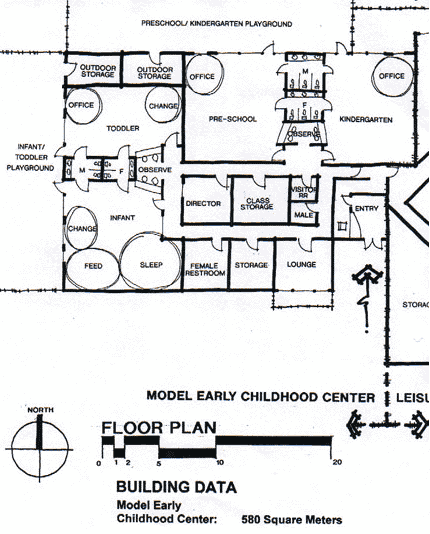
Our conceptual design for the model/early childhood center in Qatar which will be modified after more research.
Homes and schools in Qatar are designed in the traditional Middle Eastern style with a walled entry from the outside. Entry to homes and schools are protected for a variety of reasons, some practical and some historical. Historically the walled entrance became a barrier to outside tribes and protected the women from being abducted or carried off. In more modern times the walled and gated entrance is used to control male access to buildings where women may be present. For modesty reasons, the women choose to stay covered (veiled) in the presence of non-related males. A protected and windowless entrance means that unwelcome men will not show up and surprise working women. Behind a secluded, safe atmosphere women can feel safe to uncloak and unveil. Since education is traditionally separated by gender after preschool, you mostly find women working in girl's schools and child care centers in Qatar. Notice on our conceptual design, the entry is gated and requires a zigzag entry, which guarantees that no one can be seen from the outside. The design also reflects other areas in the building where modesty might be an issue. Diaper changing stations will need to be partially screened from the observation windows and additional bathrooms have been added in all classrooms so that the genders can be separated. Parents of this culture have very strong beliefs and values about the separation of gender in using toileting facilities. In fact, the restroom facilities will have to be uniquely designed to facilitate sanitation techniques after restroom use. These unique washing requirements will also be carried out in the final design of the infant/toddler diapering areas. These issues are all very sensitive areas to explore. Doing the research allowed us to understand some very unique restroom and diapering requirements. Restroom and diaper changing stations are an important element of any early childhood facility.
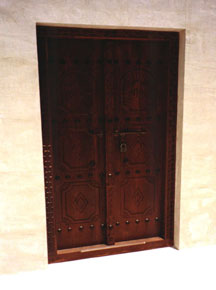
Doors are a symbol of hospitality in some cultures.
The design of doors, important symbols of Arab hospitality, the shape of windows domes, parapeets, and Arabesque decoration contribute to the character and charm of Islamic architecture. Islam has played a major role in influencing design since the dominent example of Islamic architecture is the mosque.
In fact, this architectural style is also reflected in many places in Europe that were once occupied by the Moors. These features and architectural details will be incorporated into the final design process in order to preserve the richness and heritage of Islamic design, which has evolved over centuries.
Wind towers were a unique architectural feature of this part of the world before air conditioning and may be incorporated into the final design. They are often times still seen on new homes even though they have lost their original function. These graceful towers are divided into four shafts which draw air into the house down one side and force it out of the other, causing a cooling draft in the room below. The fact that they are still being incorporated into new architectural styles even though their function has been lost due to air conditioning, attests to this culture's interest in preserving traditional Islamic designs.
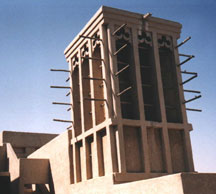
A wind tower is a traditional architectural feature which is an important symbol to the peopple of the Gulf region.
CONCLUSION
Over a year has passed since our original trips to Qatar. Our clients are diligently working on getting a permit for the project. I continue to study and read about the culture, including reading the Quran. It has been said that once your heart touches the sands of Arabia you will be mysteriously drawn back to this sacred peninsula. Indeed, I have spent the summer in another Persian Gulf country, Dubia in the United Arab Emirates, studying their culture for another children's project. Unlike their traditional neighbor, Qatar, the city of Dubai has been greatly influenced by Western society. The sprawling and rising city has little that reflects the beauty of Islamic architecture. Instead, timeliness high apartments reach toward the sky looking more like boxless forms than anything else. Veiled and masked women mingle in great shopping malls with Europeans and American wearing shorts and Indians wearing traditional or western clothing.
During my stay I have spent countless hours interviewing and observing local Arab families and visiting primary schools and child care centers. As usual I have made many Arab friends who are trying to help me understand their ways. I am sometimes overcome with emotions by the ways in which the local people, particularly the women, have accepted me into their sometimes secret and often misunderstood world. I often times found myself in the presence of groups of veiled and cloaked women and we struggled to communicate and understand each other. Always I have felt comfortable in their presence and as we sipped Arabic coffee or tea from small cups I marveled at the destiny that brought us together. I am grateful for their openness and hospitality in answering my probing questions. I only hope that I can make a contribution to their society by providing examples of early childhood facility design that is culturally competent and supports and enhances their traditions, values, and norms. Insha Allah (God willing) - a Muslim way to define the future - I will soon return there to continue our work.
References
- Hajar, Rachel, "Brides of the Desert", Culture Corssroads, Qatar Ministry of Foreign Affairs: March 1998.
- Stoecklin, Vicki L. and R. White, "Designing Quality Facilities", Newsbreak, Chapel Hill, NC: 1998,
- - Lynch, E. and M. Hanson, "Developing Cross Cultural Competence", Paul Brookes Publishing Company, Baltimore, MD: 1995.
Vicki L. Stoecklin is the Education and Child Development Director with White Hutchinson Leisure & Learning Group, a Kansas City, MO firm, which specializes in design and consulting for children's environments including children's museums, children's leisure and entertainment sites, schools, child care facilities and outdoor environments which use nature. Vicki has a Master's degree and twenty-three years experience studying and working with children including children with disabilities. She can be reached at voice: +1.816.931-1040, fax 816-756-5058, Missouri relay (TTY) 800-735-2966 and e-mail

